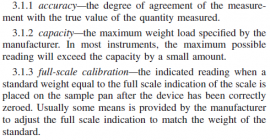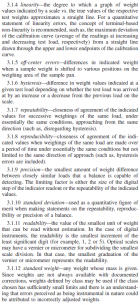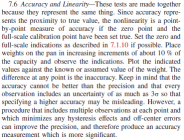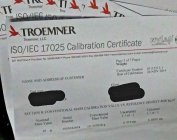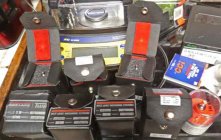more comments 
Linearity is the error between the zero and cal points not attributed to calibration error, zero error, or repeatability.
Cal at 10, 20 and 50 grams on a 100 gram scale and the max linearity error would "probably" be right in the middle of two adjacent cal points. Powder charges of 2 or 3 grams are close to zero on a 100 gram scale.
Linearity error is what you would expect by calibrating @ 50 grams and weighting 10, 20, 30 grams.
With 0.02 readability digital roll over could indicate 29.98 grains with 29.97 grains on the pan.
29.99 grains in the pan could also indicate 29.98 grains. That's with NO actual scale error.
Just a feature of digital devices. One half of the least indicated interval, +/-
Note that this rollover applies to a zero, a weighed value and the closest calibration point.
Here's a test in progress with my EJ-54D2
I bought my EJ-54D2 for $355 shipped, it is now $426 plus shipping.
I'm going to go anal on a few cases for my next 600 F-Class shoot.
More anal than normal, just to evaluate scale error.
I'll track the cases, new, sized and trimmed, primers, primed cases, charges, charged cases, bullets, and loaded rounds. Probably take a few days in my spare time
6mm HAGAR CASE PREP
10G (ASTM Class 1) WITH 20G CAL
10.0000 9.9998 9.9998 10.0000 9.9998
NEW CASES weight in grams
1 8.1826 1826 1826 1826 1824 avg 8.18256 grams
2 8.1826 1828 1828 1826 1826 avg 8.18268 grams
3 8.1828 1830 1830 1830 1830 avg 8.18296 grams
----------------------------
4 8.1838 1840 1840 1840 1840 avg 8.18396 grams
5 8.1840 1840 1840 1842 1842 avg 8.18408 grams
6 8.1844 1844 1842 1844 1842 avg 8.18432 grams
10G
9.9998 9.9998 10.0000 9.9998 10.0000
I now have them sized to 22 NOSGAR and trimmed to 1.765".
Enough for tonight.

Well, here's case #1, after trim and chamfer. I'll let it rest overnight.
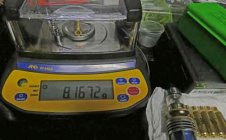
10G
9.9998 9.9998 10.0000 9.9998 10.0000
SIZED AND TRIMMED TO 22 NOSGAR 1.765"
1 8.1672 .1674 .1674 .1672 .1672 avg 8.16728
2 8.1694* .1692 .1692 .1690* .1692 .1692 avg 8.16920
3 8.1702 .1704 .1702 .1704 .1704 avg 8.17032
----------------------------
4 8.1704 .1702 .1704 .1702 .1706* .1702 avg 8.17033
5 8.1722* .1720 .1720 .1718 .1718 .1720 avg 8.17197
6 8.1720* .1718 .1716* .1718 .1718 .1718 avg 8.17180
I took an extra reading when range exceeded 0.0002g
10G
10.0000 10.0000 10.0000 9.9998 10.0000
Total range of the 6 cases is 126.040grains to 126.113 grains (0.073 grains)
Case #1 will be a sighter. Avg of #2 thru #6 is 126.092 grains (a range of 0.043 grains)
Just don't bother weighing CCI primers
Linearity is the error between the zero and cal points not attributed to calibration error, zero error, or repeatability.
Cal at 10, 20 and 50 grams on a 100 gram scale and the max linearity error would "probably" be right in the middle of two adjacent cal points. Powder charges of 2 or 3 grams are close to zero on a 100 gram scale.
Linearity error is what you would expect by calibrating @ 50 grams and weighting 10, 20, 30 grams.
With 0.02 readability digital roll over could indicate 29.98 grains with 29.97 grains on the pan.
29.99 grains in the pan could also indicate 29.98 grains. That's with NO actual scale error.
Just a feature of digital devices. One half of the least indicated interval, +/-
Note that this rollover applies to a zero, a weighed value and the closest calibration point.
Here's a test in progress with my EJ-54D2
I bought my EJ-54D2 for $355 shipped, it is now $426 plus shipping.
I'm going to go anal on a few cases for my next 600 F-Class shoot.
More anal than normal, just to evaluate scale error.
I'll track the cases, new, sized and trimmed, primers, primed cases, charges, charged cases, bullets, and loaded rounds. Probably take a few days in my spare time
6mm HAGAR CASE PREP
10G (ASTM Class 1) WITH 20G CAL
10.0000 9.9998 9.9998 10.0000 9.9998
NEW CASES weight in grams
1 8.1826 1826 1826 1826 1824 avg 8.18256 grams
2 8.1826 1828 1828 1826 1826 avg 8.18268 grams
3 8.1828 1830 1830 1830 1830 avg 8.18296 grams
----------------------------
4 8.1838 1840 1840 1840 1840 avg 8.18396 grams
5 8.1840 1840 1840 1842 1842 avg 8.18408 grams
6 8.1844 1844 1842 1844 1842 avg 8.18432 grams
10G
9.9998 9.9998 10.0000 9.9998 10.0000
I now have them sized to 22 NOSGAR and trimmed to 1.765".
Enough for tonight.

Well, here's case #1, after trim and chamfer. I'll let it rest overnight.

10G
9.9998 9.9998 10.0000 9.9998 10.0000
SIZED AND TRIMMED TO 22 NOSGAR 1.765"
1 8.1672 .1674 .1674 .1672 .1672 avg 8.16728
2 8.1694* .1692 .1692 .1690* .1692 .1692 avg 8.16920
3 8.1702 .1704 .1702 .1704 .1704 avg 8.17032
----------------------------
4 8.1704 .1702 .1704 .1702 .1706* .1702 avg 8.17033
5 8.1722* .1720 .1720 .1718 .1718 .1720 avg 8.17197
6 8.1720* .1718 .1716* .1718 .1718 .1718 avg 8.17180
I took an extra reading when range exceeded 0.0002g
10G
10.0000 10.0000 10.0000 9.9998 10.0000
Total range of the 6 cases is 126.040grains to 126.113 grains (0.073 grains)
Case #1 will be a sighter. Avg of #2 thru #6 is 126.092 grains (a range of 0.043 grains)
Just don't bother weighing CCI primers
Last edited:










